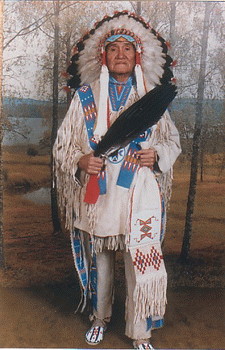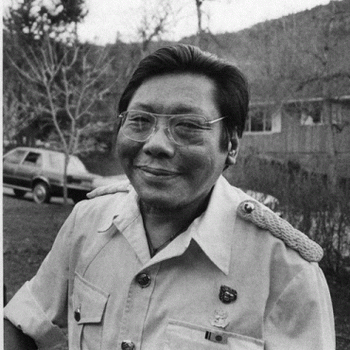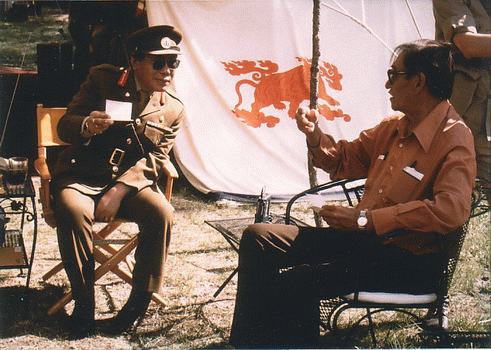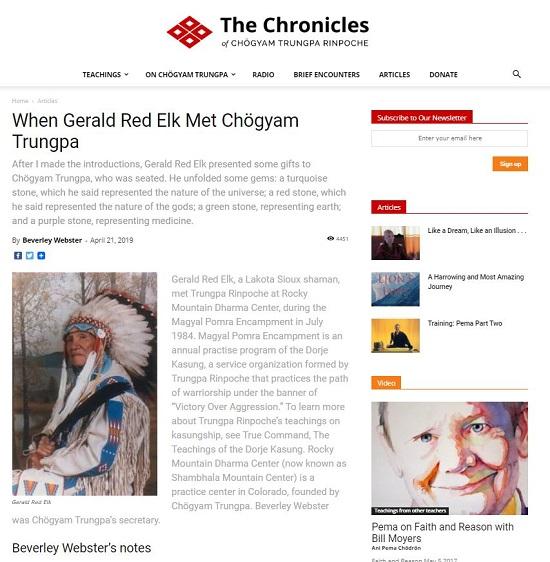Trungpa
from:
CTR
Chronicles



Rocky Mountain Dharma Center
Photo by Andrea Roth 1984
Gerald Red Elk
Gerald Red Elk, a Lakota Sioux
shaman, met Trungpa Rinpoche at Rocky Mountain Dharma
Center, during the Magyal Pomra Encampment in July 1984.
Magyal Pomra Encampment is an annual practise program of the
Dorje Kasung, a service organization formed by Trungpa
Rinpoche that practices the path of warriorship under the
banner of “Victory Over Aggression.” To learn more about
Trungpa Rinpoche’s teachings on kasungship, see True
Command, The Teachings of the Dorje Kasung. Rocky Mountain
Dharma Center (now known as Shambhala Mountain Center) is a
practice center in Colorado, founded by Chogyam Trungpa.
Beverley Webster was Chogyam Trungpa’s secretary.
Beverley Webster’s notes
Prior to the meeting, Ani Pema
Chodron, Martha Espeset and myself, drove from the
encampment grounds down to Rocky Mountain Dharma Center
(RMDC) to meet Gerald Red Elk and his adopted nephew Roger
La Borde. Rinpoche had asked me to explain a little about
the encampment activities, uniforms, etc. I also wanted to
introduce him to RMDC and tell him about the center’s
activities.
As we were driving into the main
compound of RMDC, we spotted Gerald Red Elk and Roger La
Borde sitting under a tree with a picnic basket beside them.
They told us they had been there for about an hour and had
had a leisurely lunch. We then invited them to the dining
room where we sat and talked for about 15 minutes. Gerald
Red Elk talked about why he had requested to see Chogyam
Trungpa. He described the declining situation of his people,
as well as the changing of the cycles according to native
American tradition. He said that we were now passing out of
the Eagle Cycle, and entering the Serpent Cycle. He also
said that he thought his people would have difficulty making
the transition because of alcohol and drugs.
We drove two cars back up to the
encampment ground. Ani Pema Chodron accompanied Gerald Red
Elk and Roger La Borde. Martha and I led the way. We parked
the cars, and continued on foot, entering the encampment
grounds through the main tori gate. I was inclined to
describe everything that was visible to Gerald Red Elk.
Shibata Sensei was teaching a kyudo class, the shrine tent
was being set up, and various activities were taking place
throughout. When I looked at Gerald Red Elk, however, he
seemed to be taking everything in and not wanting
commentary. I was then inclined to describe very little to
him.
When we arrived at Rinpoche’s
compound, I asked the party to wait while I spoke briefly
with Rinpoche. He had previously mentioned that he wanted me
to attend the meeting in order to take notes, pending
permission from Gerald Red Elk. I suggested that Ani Pema
attend and also Dr. Levy, who had expressed a great interest
in meeting the shaman. Rinpoche also invited Walter Fordham
to join the meeting. A circle of chairs was arranged near
Rinpoche’s tent; the party gathered and awaited Rinpoche’s
arrival. The shaman was to be seated to Chogyam Trungpa’s
left, with Roger La Borde beside him. Gerald Red Elk gave me
permission to record the interview, with the warning that
the equipment may or may not work, according to the will of
the [word omitted]. I therefore prepared myself with
pencil and paper.
When Chogyam Trungpa arrived, Gerald
Red Elk stood up and the rest of the party followed suit.
After I made the introductions, Gerald Red Elk presented
some gifts to Chogyam Trungpa, who was seated. He unfolded
some gems: a turquoise stone, which he said represented the
nature of the universe; a red stone, which he said
represented the nature of the gods; a green stone,
representing earth; and a purple stone, representing
medicine.
As I was fiddling with the suspect
tape recorder, the following conversation between Gerald Red
Elk and Chogyam Trungpa ensued.
Chogyam Trungpa (CTR): I think it is
going to rain tomorrow.
Gerald Red Elk (GRE): I think
probably in a few hours.
CTR: I think it will rain tomorrow
morning.
GRE: I think it will rain soon, you
can tell because the clouds are low.
(The first part of the conversation
was about Little Joe. Chogyam Trungpa asked Gerald Red Elk
if he had known him. Gerald Red Elk said that Ani Pema
Chodron had also asked about him about Little Joe, and he
had told her that Little Joe had died.)
CTR: He blessed us with feathers and
sage.
GRE: We do that too. Unfortunately,
our holy men are leaving us. But they finished what they
were supposed to do here. I wanted to meet and talk to you
because when we went back to our old ways, the gods showed
us things. Some things we understand, some things we do
not.
(He then proceeded to show papers to
Chogyam Trungpa, upon which were drawings of symbols. He
described the rock, upon which he had seen the symbols, as
being a medium rock. The first symbol he showed Chogyam
Trungpa was a circle enclosing a cross.)
CTR: It is very close to our logo.
(He pointed to the TLGD flag with the six dots.)
(Gerald Red Elk then described the
procedure for the symbols appearing on the rock as
follows.)
GRE: [It happens] during sun
dance. Wait five minutes and the sign starts coming out.
That was the first. This is the second and third.
(He showed Rinpoche a pictograph
with 16 rays.)
GRE: One time, it had two eyes, next
time, it had three eyes. But these are buffalo
tracks.
CTR: It is also like the flag there
with the sun on it.
(Rinpoche pointed to the Sawang’s
flag.)
GRE: But the next time, it had this
on it … It was higher, then got smaller. But, this is
always here — two things on top, eyes and mouth. It moved
from the center down, just these three tracks. It is like
someone takes fingers and draws in the moss. (Gerald Red Elk
made a circular motion with his finger.) Very small. The
gods were trying to tell us eight years ago that we had to
pray hard.
GRE: The holy men in Mexico, sent
the Aztecs up. They wanted holy men from Canada and our
tribes to go down. That is what the tracks meant. But we
could not [go]. We know your people have knowledge.
So we’ve come to see what it means to you, so we could
learn.
CTR: We could work
together.
GRE: Another thing. We have these
round stones. When we move, they move. They have eyes. Our
people call them Star People. They start to shine. The
Tibetans saved a civilization in the past by calling on the
Star People. So, I was wondering if they are the
same?
CTR: I think we could work
together.
GRE: Our young want this knowledge
now, so we are giving it to them … but not to everyone. We
need to teach to other people for the future. The pipe
itself was brought when the people first appeared on the
plains, from the constellation of the Seven Sisters. There
were two braves and they saw movement in the hills. They saw
one girl with a bundle on her back. One of the braves said,
“Let’s have fun with her.” Then the other one noticed that
she was not walking on the ground and said, “This is no
ordinary being.” Within hearing distance she said, “Father
has sent me in order for me to go to a place to use the
pipe. Prepare the gound with sweet grass and sage! She then
said, “You, young man, come for what you are after.” When
the brave who had wanted to have fun with her put his arms
around her, a cloud came down and all that was left were his
bones. You could see her breath the next morning.
The pipe should be used for praying.
There is an ordinance for when you fill the pipe.
If you do it this way
If you do it this way
Whatever you [word
omitted]
Whatever you want
you shall receive
In English you say, “Ask and you
shall receive.” If you do it that way, Grandfather god will
look at you. You must repeat it three times. The reason is
… I want to live and I want my people to live.
God’s main color is royal blue, like
the sky. He owns the universe. Everything we do and get, he
allows. His color is royal blue. Sun is red and gold for the
East. The deity in the South is red. In the West, it is half
navy blue and half black — Thunderbird people. North is
wisdom, white. Prayer flags have seven colors, green is the
earth and purple is medicine — from medicine plants comes
purple juice. Put prayer flags on hills and tie to trees.
Use tobacco and feathers and the incense of sweet grass,
sweet sage, sweet pine, sweet cedar and juniper. We purify
on the same order as Buddhists who paint their gods blue. It
all coincides. I came four years ago, but couldn’t get to
you.
CTR: We have to work
together.
GRE: I believe that too, Sir. The
eagle was given to us at the beginning. The two central
plumes are sacred. The four biggest are sacred. There are
five kinds of feathers. The first is white with a narrow
black tip, when the bird is young. As it grows old, the
black grows. The bald eagle has all white, then it gets
speckled as they grow older, and gets dark too.
GRE: In dreams, tell them to use
certain kinds of feathers. Use dark feathers with white
speckles. That is what we know … The eagle is now. The
next [cycle] will be the serpent. They told us a lot
of things. In 1978 and 1979, the holy men said the changes
are starting. When they were doing the ghost dances, it was
said by Grandfather god: “This time, I made the white man
first. So, I am waiting to see what he is going to
do.”
This civilization is in a bad state
of mind. Floods and earthquakes were starting to get severe
in 1980, and it will be getting worse this year. That is the
main reason why our young realize and they want to learn.
That will help them to survive. I wished I could have
brought a few.
(Gerald Red Elk looks and gestures
towards the encampment grounds.)
We want our young to know it too. At
home, it is very hard to see this.
(Roll of thunder)
CTR: It is very magical.
GRE: You tell them these things.
There are unbelievers. They don’t pay any
attention.
I feel I have seen him before. There
are a lot of people I have met before, like you. (Gerald Red
Elk points to Dr. Levy.)
They [the young] need to
gain peace of mind and be themselves. They would be real
healthy if they came up here. Now, they are negative minded.
They have hate in themselves. They must learn how to defend
themselves, but not hate.
(Chogyam Trungpa asks his kusung
[attendant] for a copy of Shambhala: The Sacred Path
of the Warrior. He signs the book “Chogyam Mukpo”, and
presents it to Gerald Red Elk.)
CTR: This is my latest book. I give
it to you.
GRE (pointing to the title): “The
Sacred Path of the Warrior.” This is what we believe in. The
honor is there. The honor is there.
CTR: Thank you for
coming.
(They stand up together and
embrace.)
CTR: I think something
extraordinarily good will come out of this. Thank
you.
As Gerald Red Elk and Roger La Borde
walked away, Chogyam Trungpa said: “He understood the book
just by looking at the cover.”
The rain began and slowly increased
in intensity as Gerald Red Elk and Rodger La Borde walked
down the hill toward their car. Dr. Levy, Ani Pema Chodron,
and I were with them as they departed. Commenting on the
rain, Gerald Red Elk said: “We have their
blessings.”
At RMDC, Gerald Red Elk made these
comments about the signs for the end of this cycle. He said:
“[The end of the cycle will come] when the buffalo
has lost all its hair and is standing on its last leg, when
white man produces and publishes picture of [word
omitted], when Tibetans came to the Hopi … Could be in
a few years, or a hundred years (laughs).”
We learned later that after they
drove away from RMDC, Gerald Red Elk asked Roger to stop the
car. They got out and Gerald Red Elk and Roger sat together
in the rain.
Further recollections
What I remember after returning to
Rinpoche’s tent is that he was sitting outside under the
small flap extension of the tent, which kept falling in
because the rain was so heavy. We asked him to go inside but
he refused … He had something in his hand, maybe a riding
crop, not sure. Anyway, he stayed put for a long time while
the kusung were holding up the tent flap. -Beverley H
Webster in a letter to Walter Fordham, 9 May 2006
At the very beginning of the
meeting, while Rinpoche and Gerald Red Elk talked about the
prospects of rain, we were sitting under a cloudless blue
sky. There was no sense of an impending storm. The clouds
formed quickly as they talked. By the time they said
goodbye, the sky was dark and ominous.
As Gerald Red Elk and Roger La Borde
were departing, the rain began to fall gently. Rinpoche
moved to a chair in front of his tent. He was holding a
riding crop in his hand. He said: “It’s so sad. It’s so
sad.” While he was saying this, he slammed his fist, still
holding the riding crop, down on his knee. A few moments
later, the rain came down harder, much harder. It was a
deluge. His kusung asked if he wanted move inside. Rinpoche
ignored him. Rinpoche was crying, and continued to say:
“It’s so sad.” After awhile, maybe 10 or 15 minutes, he
said: “That’s enough,” and gestured with his riding crop.
Within a few moments the rain slowed down, and then
stopped.
Later that evening, Rinpoche
explained more about the medium rocks. He said that the
divination ceremony begins with a smooth, moss covered rock.
The symbol or message appears on the rock itself, beneath
the moss. This serves as proof that the symbols are not
carved or chiseled by hand, but that they simply
appear.
Rinpoche also explained that the
Star People were dralas.
Later I learned that Red Elk had
cancer. At the time of his meeting with Rinpoche, he knew
that he was dying. He passed on about a year
later.
Under Rinpoche’s instructions,
several levels of Shambhala Training were conducted at a
Lakota Sioux reservation, which I believe was in South
Dakota. What do others remember about this?
-Walter Fordham, May 20,
2011
More:
